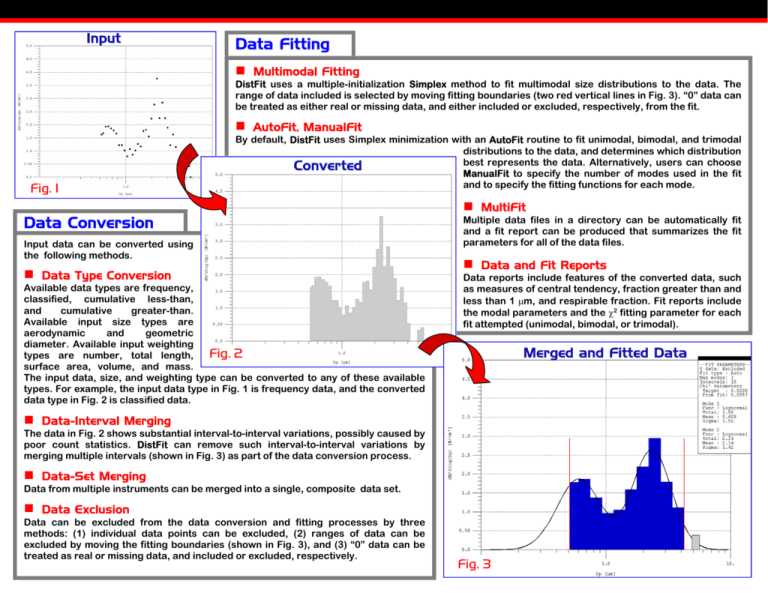
Input
Data Fitting
Multimodal Fitting
DistFit uses a multiple-initialization Simplex method to fit multimodal size distributions to the data. The
range of data included is selected by moving fitting boundaries (two red vertical lines in Fig. 3). “0” data can
be treated as either real or missing data, and either included or excluded, respectively, from the fit.
AutoFit, ManualFit
Fig. 1
By default, DistFit uses Simplex minimization with an AutoFit routine to fit unimodal, bimodal, and trimodal
distributions to the data, and determines which distribution
best represents the data. Alternatively, users can choose
Converted
ManualFit to specify the number of modes used in the fit
and to specify the fitting functions for each mode.
Data Conversion
Input data can be converted using
the following methods.
Data Type Conversion
Available data types are frequency,
classified, cumulative less-than,
and
cumulative
greater-than.
Available input size types are
aerodynamic
and
geometric
diameter. Available input weighting
Fig. 2
types are number, total length,
surface area, volume, and mass.
The input data, size, and weighting type can be converted to any of these available
types. For example, the input data type in Fig. 1 is frequency data, and the converted
data type in Fig. 2 is classified data.
MultiFit
Multiple data files in a directory can be automatically fit
and a fit report can be produced that summarizes the fit
parameters for all of the data files.
Data and Fit Reports
Data reports include features of the converted data, such
as measures of central tendency, fraction greater than and
less than 1 µm, and respirable fraction. Fit reports include
the modal parameters and the χ2 fitting parameter for each
fit attempted (unimodal, bimodal, or trimodal).
Merged and Fitted Data
Data-Interval Merging
The data in Fig. 2 shows substantial interval-to-interval variations, possibly caused by
poor count statistics. DistFit can remove such interval-to-interval variations by
merging multiple intervals (shown in Fig. 3) as part of the data conversion process.
Data-Set Merging
Data from multiple instruments can be merged into a single, composite data set.
Data Exclusion
Data can be excluded from the data conversion and fitting processes by three
methods: (1) individual data points can be excluded, (2) ranges of data can be
excluded by moving the fitting boundaries (shown in Fig. 3), and (3) “0” data can be
treated as real or missing data, and included or excluded, respectively.
Fig. 3
Merging multiple data sets
DistFit can be used to merge multiple component data sets, such as
TSI SMPS and APS data sets, into a single, composite data set. DistFit
optionally rescales and then merges multiple data sets, and then fits
multimodal functions to the composite data set.
SMPS Data
APS Data
Composite Data
DistFit is a program to
manipulate particle size
distribution data and to
fit
multimodal
distributions to the data.
The need for DistFit
arises from the particular
problem
of
handling
conversions between the
many data types used to
represent particle size
distributions.
For
example, a measured
number size distribution
might be converted to a volume distribution. The measured particle size
might be aerodynamic diameter, yet it is more common to display the
geometric diameter. Data can be entered into DistFit as frequency,
classified, cumulative less-than, or cumulative greater-than, and
converted to any of the other data types. DistFit then fits unimodal or
multimodal distributions (lognormal or Rosin-Rammler) to the sizedistribution data. Finally, classifications of the data, such as the
submicron/supermicron fractions, respirable fractions, and PM
(particulate matter) fractions, can be calculated.
DistFit Features
Free demo version available
Fit multimodal particle size distributions
Educational discount available
Convert data type
More details about DistFit available online at www.Aerosols.com
Features currently under development include reading instrument data
Merge multiple data intervals
Merge multiple data sets
Copyright 2006. All rights reserved.
Chimera Technologies, Inc.
15051 Zodiac St. NE
Forest Lake, MN , USA 55025
Tel: 1-651-464-7771
Email: info@Aerosols.com
Website: www.Aerosols.com
Exclude selected data from fit
Automatically fit multiple data sets
Produce reports on data and fitted functions






